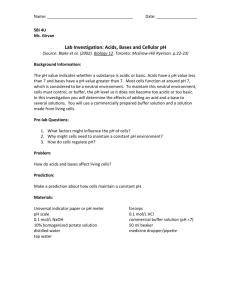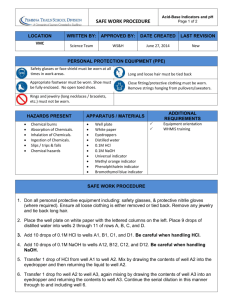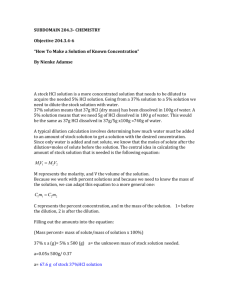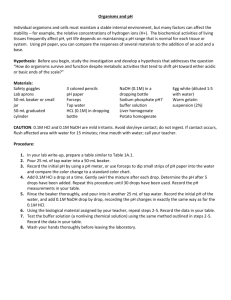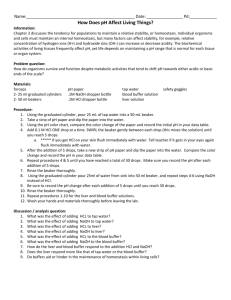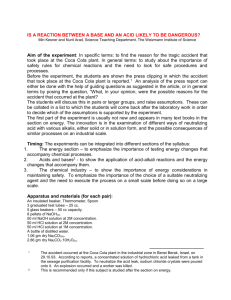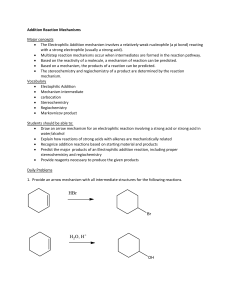Data
advertisement
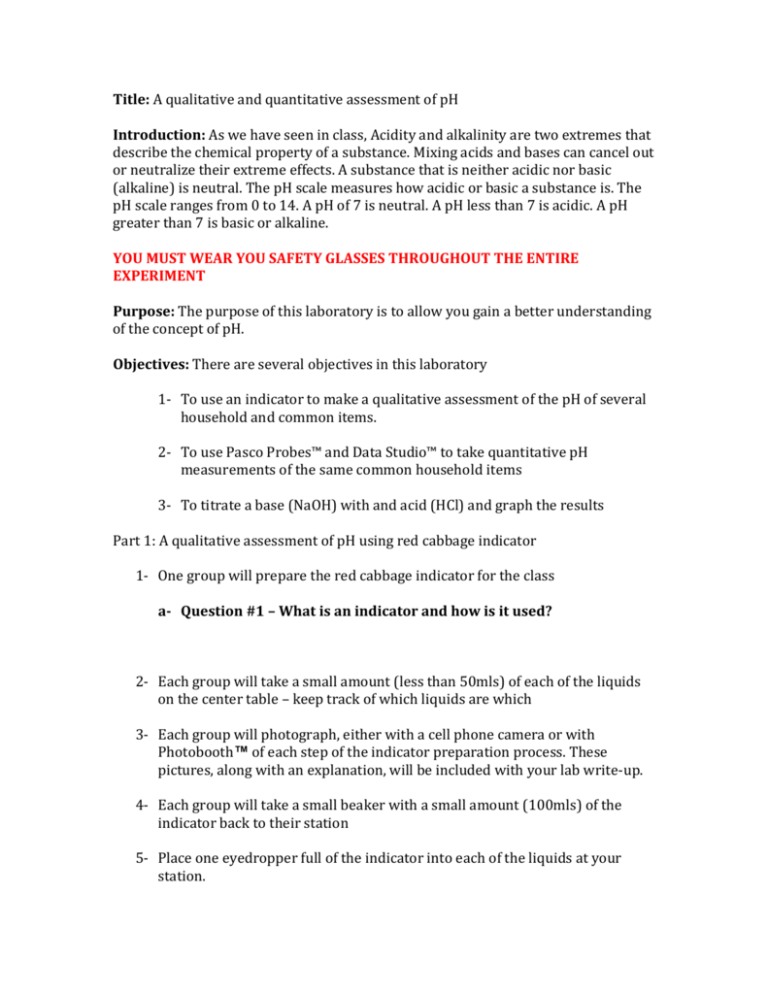
Title: A qualitative and quantitative assessment of pH Introduction: As we have seen in class, Acidity and alkalinity are two extremes that describe the chemical property of a substance. Mixing acids and bases can cancel out or neutralize their extreme effects. A substance that is neither acidic nor basic (alkaline) is neutral. The pH scale measures how acidic or basic a substance is. The pH scale ranges from 0 to 14. A pH of 7 is neutral. A pH less than 7 is acidic. A pH greater than 7 is basic or alkaline. YOU MUST WEAR YOU SAFETY GLASSES THROUGHOUT THE ENTIRE EXPERIMENT Purpose: The purpose of this laboratory is to allow you gain a better understanding of the concept of pH. Objectives: There are several objectives in this laboratory 1- To use an indicator to make a qualitative assessment of the pH of several household and common items. 2- To use Pasco Probes™ and Data Studio™ to take quantitative pH measurements of the same common household items 3- To titrate a base (NaOH) with and acid (HCl) and graph the results Part 1: A qualitative assessment of pH using red cabbage indicator 1- One group will prepare the red cabbage indicator for the class a- Question #1 – What is an indicator and how is it used? 2- Each group will take a small amount (less than 50mls) of each of the liquids on the center table – keep track of which liquids are which 3- Each group will photograph, either with a cell phone camera or with Photobooth™ of each step of the indicator preparation process. These pictures, along with an explanation, will be included with your lab write-up. 4- Each group will take a small beaker with a small amount (100mls) of the indicator back to their station 5- Place one eyedropper full of the indicator into each of the liquids at your station. a- Question #2 - What color does the liquid change in the presence of an acid? Base? Neutral substance? 6- Place the solutions in order from the most acidic to the most basic. This should be photographed and included in your write-up 7- Based on the chart below make an educated guess as to the pH’s of each of the samples before you. Record each liquid and what you think it’s pH is. Data Part 2 – Quantitative Assessment #1 1- Plug in the Pasco ™ probe into the USB port of your computer and open the Data Studio ™ software. The probe must be plugged in before the software is opened. 2- Place the probe into the first cup and record the actual pH. 3- Rinse off the probe with distilled water and place it into the second beaker. 4- Continue until you have the correct pH’s for each of the liquids. 5- RECORD your results using an Excel ™ graph – the graph must be properly labeled with a title, correct axes,.. a- Question #3 – How did your estimate compare to the actual pH values. Were your estimates generally more acidic or basic than the actual pH values? Part 3 – Quantitative Assessment #2 – Titration Exercise 1- Pour 50mls of 0.1M NaOH into a 150ml glass beaker 2- Pour 50mls of 0.1M HCL into a second 150ml glass beaker MAKE SURE YOU KNOW WHICH BEAKER IS WHICH! 3- Using the data table below record the pH of the beaker with NaOH 4- Place 5 drops of the HCL into the beaker with the NaOH, gently swirl for 5 seconds and take and record the new pH 5- Continue step #4 until all 50mls of the HCL has been used 6- Using a line graph, graph the data using Excel ™ Label all axis DATA CHART pH 0.1M NaOH pH +5mls HCl pH +10mls HCl pH +15mls HCl pH +20mls HCl pH +25mls HCl pH +30mls HCl pH +35mls HCl pH +40mls HCl pH +45mls HCl pH +50mls HCl a- How many drops were needed to reach a neutral Ph? Conclusion Questions: 1- How does a difference in 1 pH unit change in terms of H+ concentration? Example: How does a pH of 3 differ from pH of 4? Which one is stronger or weaker? Why? 2- Neutralization: Whenever you mix an acid with a base, they neutralize each other. If this is the case, why is Alka- Seltzer ™ or other over the counter antacids used to treat stomach aches also called acid reflux or heartburn? (Note: excess stomach acids cause stomach aches) In general how do antacids work? Why is it called heartburn if it has nothing to do with your heart? 3- Acid Rain: What is acid rain and how is it a problem to oceans, rivers, lakes, ponds ect.? Give thorough answers. 4- Conclusion – Discuss what you learned in this lab and from the assessment questions. You do not need to recap what you actually did! *Be sure to include your pictures and graphs when you hand in your lab



